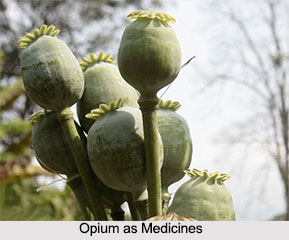 Opium appears to have been brought into India by the Muslims, as its Sanskrit name is evidently derived from the Arabic Afyun, and as it is not mentioned by the older Sanskrit writers. The capsules of the poppy are called Khakhas and the seeds, Khasatila in Sanskrit.
Opium appears to have been brought into India by the Muslims, as its Sanskrit name is evidently derived from the Arabic Afyun, and as it is not mentioned by the older Sanskrit writers. The capsules of the poppy are called Khakhas and the seeds, Khasatila in Sanskrit.
Use of Opium in Cooking
The seeds yield a bland oil, which is used for culinary purposes and in lamps. The seeds themselves are innocuous and used as food. They are boiled, mixed with a little oil and salt and taken as curry with rice, or they are made into balls and formed with tamarind, into an acid curry. Poppy seeds are sprinkled over some sorts of native sweetmeats.
Health Benefits of Opium
Sanskrit writers describe poppy seeds as demulcent and nutritive, and useful in cough and asthma. The capsules of the poppy are regarded as light, astringent and narcotic. They promote talkativeness and destroy or diminish the sexual power. The properties of opium are said to be analogous to those of the capsules. Opium is used as an astringent and narcotic in bowel complaints, cough, external inflammations, urinary diseases, fractures, skin diseases, etc.
Dose of Opium in Medicine
In diarrhoea and cholera the following called "Amarakshasi" is used; take opium, nutmeg, cloves, cinnabar and camphor in equal parts. Beat them into a mass with water, and make into 4 grain pills.
In chronic diarrhoea and dysentery, the following called "Grahani Kapata Rasa", is recommended. To prepare this take nutmeg, borax, prepared talc and datura seeds each one part, opium 2 parts and make into 2 grain pills with the juice of Paederia foetida (prasarani).
In diarrhoea with anasasca the following, called "Dugdhavati", is much used by the Kavirajas. To make Dugdhavati; take opium and aconite 24 grains each, prepared iron 10 grains and prepared talc 12 grains. Beat them into a mass with milk and make into 4 grain pills. One pill is to be given every morning with milk. The diet is restricted to milk alone, water and salt being prohibited.
In fever with diarrhoea, opium is used in combination with arsenic, as for example in the following preparation.
"Sambhunatha Rasa": Take orpiment, realgar, cinnabar, white arsenic, borax, aconite and alum each one part, mercury, sulphur and opium each 7 parts. Soak them for 7 days in each of the following fluids, namely, juice of the leaves of Cannabis sativa, Vitex Negundo, datura and neem. Make into 2 grain pills. These are given with ginger juice in diarrhoea with high fever.
"Akaradi Churna": Take pellitory root, ginger, kakkola seeds, saffron, long pepper, nutmeg, cloves and red sandalwood each 2 tolas, opium 8 tolas. Rub them together and pass the powder through a cloth. Then add sugar, equal in quantity to all the above ingredients. Dose should be 6 to 12 grains with honey. This medicine is used as an aphrodisiac.
Opium enters into the composition of some external applications in the form of paste, along with other medicines. A poultice made of poppy seeds with milk is prescribed by Sarangadhara in porrigo of the scalp.
The Amritasagar recommends the following preparation of opium in diabetes; take camphor and musk each one part, opium and mace each 4 parts. Make into 2 grain pills. They are administered with the juice of betel leaves.
Related Articles
History of Ayurveda
Origin of Ayurveda
Ayurveda Medication
Elements of Ayurveda
Concepts of Ayurveda
Ancient Literature of Ayurveda
Sushruta Samhita




















